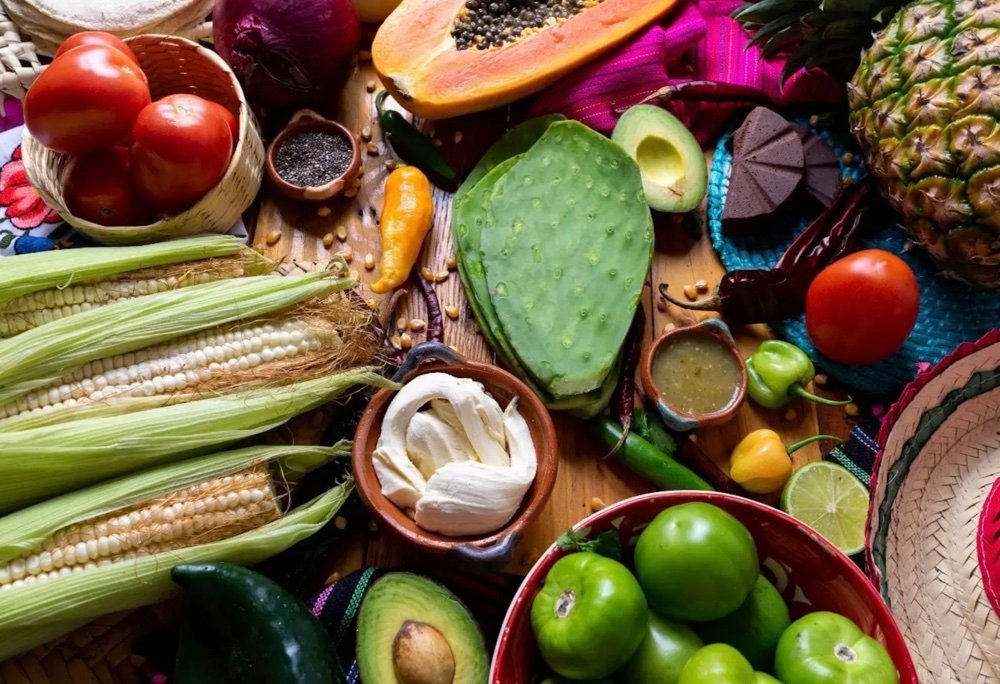
Mexican Random Food
Mexican food is extensive and very diverse. The ingredients are quiet and little known. Many of these brought after the conquest were mixed with those the Spanish brought from Europe. Some of these were adopted by many countries. For example: tomatoes, potatoes, vanilla, chocolate, and chili peppers, among others.
Now, let’s look at what everyone knows when they think about Mexican food and drinks: tacos, enchiladas, and tequila. But Mexico is not only known for these things. The amount of ingredients are immense and many of them are not that popular – unless you visit the country and take the risk of trying some new. You can find strange and unknown things, but these will usually turn out to be delicious and found in many different dishes.
Today, we will introduce you to some of the foods and/or ingredients that are not so popular in other countires, but are very popular in Mexico.
NOPAL
The nopal is a plant native to Mexico and belongs to the Cactaceae family. It has been naturalized and cultivated in other countries, especially Spain, Italy, and North Africa. This is because it was introduced to Europe by the Spanish conquerors. The nopal is a fleshy, arboreal plant with stems that are flat, medium green in color, and can have two types of thorns, some long and hard, and others short and fine.
It can be cooked in different ways. Its slightly acidic flavor is reminiscent of green beans and asparagus, and it mixes very well with avocado, egg, corn, cucumber, pepper, carrot, tomato, garlic, onion, oregano, and any chili pepper. It is a versatile product that can be eaten raw or fried, boiled, steamed, grilled, roasted. There is even a flour derived from it. It is ideal as an ingredient in salads, stews, soups, marinades, and even used to prepare jams, desserts, or drinks. Recent studies indicate that this food is very healthy due to its high levels of fiber, in addition to having antiviral properties, it can help to reduce cholesterol, regulate blood sugar levels, and help protect nerve cells from damage caused by oxidative stress.

HUITLACOCHE
Another ingredient that some places consider a plague, in Mexico it is a true delicacy. This is a parasitic fungus that grows during the rainy season, which is between June and November. The fungus gets between the leaves that cover the corn cob and proliferates, growing until it covers a large part of it. At first sight, it has a gray color, but when cooked, it changes to a black color. It is rich in amino acids such as lysine that helps the body produce proteins. It also has essential fatty acids such as: oleic and linoleic, which are sources of Omega 3 and Omega 6. It is also low in fat and has a high fiber content. This ingredient was used in pre-Hispanic times and was reserved for the delight of rulers, chief warriors, and priests. After the conquest, it was no longer used. It wasn’t until the beginning of the 20th century that it regained popularity in Mexican foods. As mentioned before, its flavor is similar to that of a mushroom, and is used mainly in quesadillas, soups, broths, and stews.

CHAPULINES
One of the things that foreigners find very strange and sometimes disgusting is eating insects, or even drinking them.
One of these are chapulines. Theey are eaten in every state in the center and southeast of the country. Some of the first historical records come from the Mexica or Aztec culture. Its name in Nahuatl means “insect that jumps like a rubber ball.”
Chapulines, as well as crickets, grasshoppers, and locusts belong to the zoological order called Orthoptera. These insects can be found in large fields and pastures, although in many cases they are raised for consumption. It was discovered that these insects benefit the body because they contain between 60% and 70% of good quality proteins, and can be equal to or more nutritious than beef, chicken or pork. They also provide vitamins A, B, and C, along with providing calcium, zinc, magnesium, and omega 3 to the diet.
Due to its popular and exotic flavor, different products have been made from them such as sauces and snacks, and they are also used as complements in certain stews. The preparation can vary and they can be roasted or fried, depending on what is added to cook them. The flavor may vary, but can be a bit strong, like pork rinds because of how crunchy they tend to be, and a bit ferrous, like spinach.

MAGUEY WORMS
Another star from the insect group is the maguey worm. There are two varieties: the mecocuiles (or white worms) and the chinicuiles (or tecoles, red worms). The chinicuiles are known by their shade because it is between red and pink and has a size that does not exceed three centimeters in length. They grow on the roots of the agave and are usually placed in tequila or mezcal bottles. They are also ground with salt to flavor the oranges that accompany these drinks. They have an earthy flavor, and are easy to spot during the year, but their peak season is from May to October and their price is around $30 USD per kilo. On the other hand, white maguey worms are a luxurious gourmet product. In addition to their characteristic color, they are longer and measure from five to eight centimeters. They are thicker than the red variety and they cost between $50 and $80 USD per kilo.

Both are types of butterfly larvae that live in the lower leaves of the maguey and that is what they feed on. They are expensive and exclusive because very few are collected, about 3 to 4 per plant. Also, the plant dies after it is eaten.
This is another food that pre-Hispanics consumed and is still preserved as part of the food traditions in the center of the country and is included in many foods and drinks. They can be eaten in different ways, but above all they are used to cook traditional sauces, or to complement a good taco. They are also widely used as a complement to a good tequila or mezcal, or with maguey worm salt.

PLANTS
Another very important part of Mexican eating is herbs and plants. Many of these are eaten in very traditional stews and moles. There are so many that we will only mention a few popular ones.
Huazontles
This is a small plant that looks like an elongated tree and whose flowers are shaped like a ball. It has high nutritional value and contains vitamins A, B, B1, B2, B3, C, E, as well as minerals such as phosphorus, iron, and calcium (the amounts similar to milk). You can cook huauzontles stuffed with cheese, on pizza, weathered, in caldillo, with egg, with mole, or in tacos.

Chaya
This plant is found mainly in the south of Mexico. It is a large-leaved shrub, also known as the “spinach tree” or “Mayan spinach”. It is rich in iron, contains fiber, calcium, potassium, and minerals such as magnesium, sodium, copper, and zinc. It also contains vitamins A and C. Its leaves can be eaten raw in salads, but it is mainly prepared as a tea or infusion.

Chipilín
This is a thin plant that doesn’t exceed a meter in height. It is found in habitats close to pine and oak trees. Antirheumatic properties are attributed to it, because it can fight insomnia and is believed to help heal wounds.
It is mainly prepared in a traditional chipilín tamale and is typical in several states of the Republic such as Tabasco, Chiapas and Quintana Roo. It can also be consumed in soups and broths.

Verdolagas (Purslane):
This plant grows above ground, like a vine with small, curved leaves. It contains vitamins A, C, and E, and also minerals such as potassium, calcium, magnesium, and iron. Its properties are anti-inflammatory and is used as an analgesic, antioxidant, and circulation stimulant. It can be eaten raw in salads or steamed. Its juice is also extracted and can be added to smoothies.

Papalo
The papalo is a small plant with completely round leaves. It is also known as “the Aztec butterfly”. It is rich in antioxidants and minerals such as calcium, potassium, and phosphorus, and also contains vitamins A, B, and C. It is good for digestion, aids circulation, strengthens the immune system, and helps treat liver diseases. It is recommended that it be eaten raw. It is commonly used to flavor dishes like soups, sauces, salads, or as a complement to Mexican appetizers.

Romeritos
One of the best known plants used during Christmas are the romeritos. Romeritos contain vitamins A and C, calcium, fiber, and iron. Benefits attributed to it are strengthening bones, aiding digestion, keeping skin healthy, strengthening the immune system and, it is an antioxidant. They are usually prepared with mole poblano and potatoes.

Enjoy Mexican cuisine while conversing in the Spanish language with friends. Enroll in our Houston Spanish language classes and learn from native-speaking teachers.
Start Learning Spanish Today!
Ready to embark on a journey of language and culture? Join Spoken Learning today and unlock endless opportunities with our online Spanish lessons. Our dedicated native-speaking teachers will tailor learning sessions to your unique style, ensuring your success. Step into a world of connection and enrichment – start your transformative journey now!


